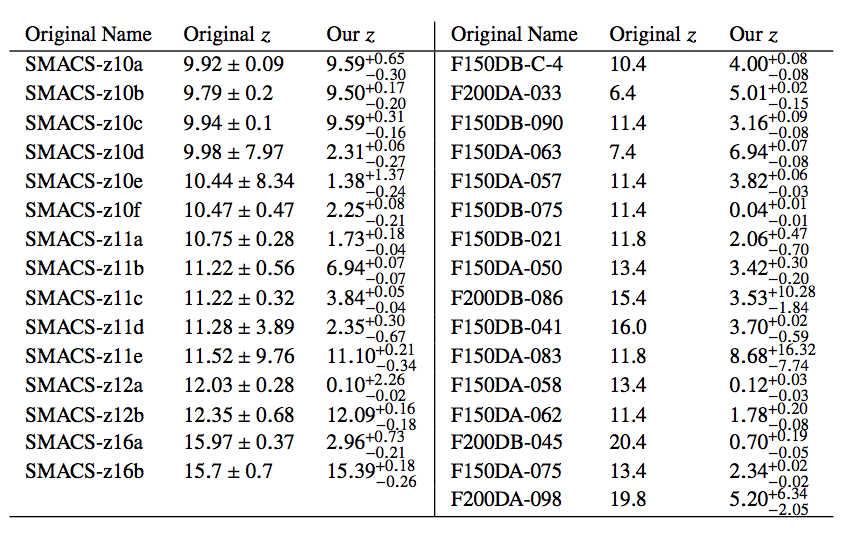I noted last time that in the rush to analyze the first of the JWST data, that “some of these candidate high redshift galaxies will fall by the wayside.” As Maurice Aabe notes in the comments there, this has already happened.
I was concerned because of previous work with Jay Franck in which we found that photometric redshifts were simply not adequately precise to identify the clusters and protoclusters we were looking for. Consequently, we made it a selection criterion when constructing the CCPC to require spectroscopic redshifts. The issue then was that it wasn’t good enough to have a rough idea of the redshift, as the photometric method often provides (what exactly it provides depends in a complicated way on the redshift range, the stellar population modeling, and the wavelength range covered by the observational data that is available). To identify a candidate protocluster, you want to know that all the potential member galaxies are really at the same redshift.
This requirement is somewhat relaxed for the field population, in which a common approach is to ask broader questions of the data like “how many galaxies are at z ~ 6? z ~ 7?” etc. Photometric redshifts, when done properly, ought to suffice for this. However, I had noticed in Jay’s work that there were times when apparently reasonable photometric redshift estimates went badly wrong. So it made the ganglia twitch when I noticed that in early JWST work – specifically Table 2 of the first version of a paper by Adams et al. – there were seven objects with candidate photometric redshifts, and three already had a preexisting spectroscopic redshift. The photometric redshifts were mostly around z ~ 9.7, but the three spectroscopic redshifts were all smaller: two z ~ 7.6, one 8.5.
Three objects are not enough to infer a systematic bias, so I made a mental note and moved on. But given our previous experience, it did not inspire confidence that all the available cases disagreed, and that all the spectroscopic redshifts were lower than the photometric estimates. These things combined to give this observer a serious case of “the heebie-jeebies.”
Adams et al have now posted a revised analysis in which many (not all) redshifts change, and change by a lot. Here is their new Table 4:

There are some cases here that appear to confirm and improve the initial estimate of a high redshift. For example, SMACS-z11e had a very uncertain initial redshift estimate. In the revised analysis, it is still at z~11, but with much higher confidence.
That said, it is hard to put a positive spin on these numbers. 23 of 31 redshifts change, and many change drastically. Those that change all become smaller. The highest surviving redshift estimate is z ~ 15 for SMACS-z16b. Among the objects with very high candidate redshifts, some are practically local (e.g., SMACS-z12a, F150DB-075, F150DA-058).
So… I had expected that this could go wrong, but I didn’t think it would go this wrong. I was concerned about the photometric redshift method – how well we can model stellar populations, especially at young ages dominated by short lived stars that in the early universe are presumably lower metallicity than well-studied nearby examples, the degeneracies between galaxies at very different redshifts but presenting similar colors over a finite range of observed passbands, dust (the eternal scourge of observational astronomy, expected to be an especially severe affliction in the ultraviolet that gets redshifted into the near-IR for high-z objects, both because dust is very efficient at scattering UV photons and because this efficiency varies a lot with metallicity and the exact gran size distribution of the dust), when is a dropout really a dropout indicating the location of the Lyman break and when is it just a lousy upper limit of a shabby detection, etc. – I could go on, but I think I already have. It will take time to sort these things out, even in the best of worlds.
We do not live in the best of worlds.
It appears that a big part of the current uncertainty is a calibration error. There is a pipeline for handling JWST data that has an in-built calibration for how many counts in a JWST image correspond to what astronomical magnitude. The JWST instrument team warned us that the initial estimate of this calibration would “improve as we go deeper into Cycle 1” – see slide 13 of Jane Rigby’s AAS presentation.
I was not previously aware of this caveat, though I’m certainly not surprised by it. This is how these things work – one makes an initial estimate based on the available data, and one improves it as more data become available. Apparently, JWST is outperforming its specs, so it is seeing as much as 0.3 magnitudes deeper than anticipated. This means that people were inferring objects to be that much too bright, hence the appearance of lots of galaxies that seem to be brighter than expected, and an apparent systematic bias to high z for photometric redshift estimators.
I was not at the AAS meeting, let alone Dr. Rigby’s presentation there. Even if I had been, I’m not sure I would have appreciated the potential impact of that last bullet point on nearly the last slide. So I’m not the least bit surprised that this error has propagated into the literature. This is unfortunate, but at least this time it didn’t lead to something as bad as the Challenger space shuttle disaster in which the relevant warning from the engineers was reputed to have been buried in an obscure bullet point list.
So now we need to take a deep breath and do things right. I understand the urgency to get the first exciting results out, and they are still exciting. There are still some interesting high z candidate galaxies, and lots of empirical evidence predating JWST indicating that galaxies may have become too big too soon. However, we can only begin to argue about the interpretation of this once we agree to what the facts are. At this juncture, it is more important to get the numbers right than to post early, potentially ill-advised takes on arXiv.
That said, I’d like to go back to writing my own ill-advised take to post on arXiv now.

Am finally truly closing in on the finish line of a speculative, toy model that proposes that astronomical scale MONDian behavior ultimately originates at the quantum scale. After completing 9 sections that exclusively dealt with quantum mechanical phenomena am finally writing section 10 which describes this proposed causal link between MOND and the atomic scale. It’s a relief to get beyond the microscale aspect of this model and on to the cosmic scale – like emerging from a dense jungle into a wide open savannah. After the savannah comes the last and really fun section of the paper titled: “Speculative Technological Implications and UAPs”. At first was squeamish about bringing up what used to be a controversial topic. But the subject has garnered considerable respectability in the last half-decade with the release of US Navy videos purporting to show UAPs filmed in infrared, as well as first-hand, eyewitness accounts from top gun pilots. In any case the UAP angle ties in nicely with key foundational elements of the paper, though, of course, like the rest of the paper it’s quite speculative.
But, now I’m a little anxious about the new data from JWST, discussed in Stacy’s last post, which might throw a monkey wrench into this toy model. But as far as I know it hasn’t changed basic features of cosmology like Big Bang Nucleosynthesis. And, having been engrossed in QM for a long time I’m finding it necessary to refresh my knowledge of astrophysics. Was just browsing Wiki’s Lambda entry, an aspect of astronomy that seems so counterintuitive. But I’m confident that reading this post “By the Wayside” and Stacy’s earlier post “A personal recollection of how we learned to stop worrying and love the Lambda”, will facilitate a better grasp of these issues.
LikeLike
One feature of the JWST first release images that I haven’t seen any comment on is the MIRI image of Stephan’s Quintet where NGC7319 (the topmost galaxy in the image) has a supermassive black hole that is actively accreting. It is very noticeable that the light from the accretion disk around it shows diffraction spikes that are not symmetrical (the 12 o’clock-6 o’clock spike seems to be missing and there is a hint of structure in the 10 o’clock-4 o’clock spike). Because the JWST has to keep its sunshade between the telescope and the sun all the time, it effectively rotates with respect to the sky and the diffraction spikes in the image will rotate with it, so by repeating the observations at suitable intervals it should be possible to possible to quantify the angular size of the source in different orientations.
https://webbtelescope.org/contents/media/images/2022/034/01G7DBCJA1M1SSGKDMH7F5XMBE
LikeLike
You are very truthful to yourself.
Therefore, you are truthful to others.
I like that.
LikeLike